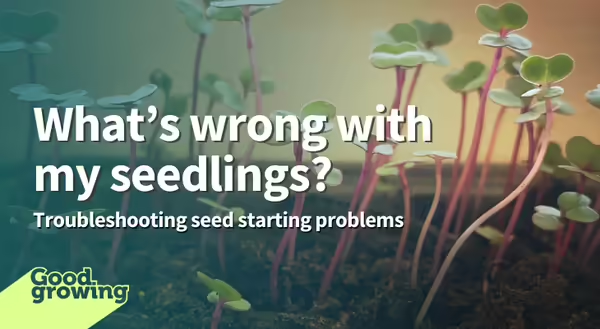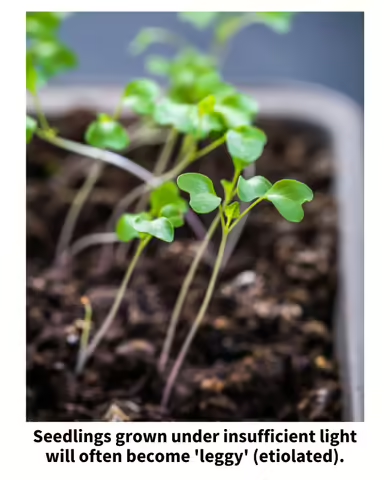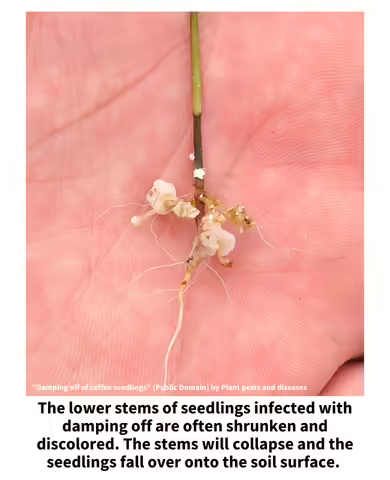
For many of us, the desire to start gardening gets stronger and stronger as we near spring. Seed starting is a popular way to kick off the gardening season. Despite the advantages and relative ease, there are a few things that can go wrong when you start your own seeds.
Why do I have long, leggy seedlings?
Not enough light
One common problem people encounter is long and leggy seedlings (etiolated). While several factors can cause this, insufficient light is the most common cause. While it is possible to start seeds on a windowsill, often, we don’t get enough light (both duration and intensity) in this part of the country for proper seedling development. Providing supplemental lighting can help prevent seedlings from getting leggy.
If you are providing supplemental lighting and your plants are getting leggy, make sure your lights aren’t too far away from your plants. Fluorescent lights are typically kept 2-4 inches above the tops of seedlings. Additionally, make sure your light bulbs aren’t too old. As fluorescent lights age, they lose some of their brightness. If you’ve been using the same lights for several years, or for an extended period of time, it may be time to replace the tubes.
Crowding
Crowded conditions can also lead to leggy plants. If there are a lot of seedlings in a cell or pot, they will compete for light which can lead to them becoming leggy. Make sure you only place a few seeds in each cell and thin seedlings once they start germinating.
Why are my seedlings dying?
There are several reasons why seedlings may die once they’ve germinated, and often it is due to too much moisture.
Too much water
When growing media has too much water in it (water-logged), there often isn’t enough oxygen present to support the roots of a plant which can lead to root dieback (the roots begin to drown). Plants growing in these conditions will often lead to plants having a wilted appearance, leading many people to water them more, further exacerbating the problem.
People often think that seedlings need to be watered daily. While this may be the case for larger plants, especially in small containers, it’s not usually the case for newly emerged seedlings. When seedlings are small, they don’t have extensive root systems and won’t take up a lot of water. Keep the growing media moist but not wet.
Damping off
Damping off can also be a cause of seedling death. It most commonly occurs when seeds are started in cool, wet soils. This disease is caused by several soil-borne fungi (Rhizoctonia spp., Fusarium spp., and Pythium spp.).
Seedlings affected by damping off will often look healthy (if they even emerge), but shortly after they emerge, they will collapse at the base of the stem and die (the pathogen infects them at or below the soil line). Unfortunately, nothing can be done once plants are infected, and they will usually die. Once plants produce true leaves and a more developed root system, they are far less likely to be infected.
Like many diseases, prevention is the best way to deal with damping off.
- Make sure you are using new, well-draining, sterile potting mix. Don’t re-use potting mix, and don’t use garden soil or compost (the pathogens can be present in these).
- If you are re-using pots and trays, sterilize them by soaking them in a 10% bleach solution for 30 minutes and rinse thoroughly.
- If you’ve had issues with damping off in the past, it may be best to use new pots and trays.
- Make sure you are planting your seeds at the proper depth
- Start seeds in a warm location, 70-75°F. Using a heating pad intended for seed starting if necessary.
- Do not overwater seedlings; the pathogens reproduce and infect plants more effectively in wet soils.
Why aren’t my seeds germinating?
Old seeds
Another issue some people encounter when starting their seed is poor or no germination. This can also be caused by various reasons, one of the most common being old seeds. Seeds only remain viable for so long; some seeds only remain viable for a year, while others may still be good after four or five years (if stored properly).
If you are using seeds you have saved from previous years, do a germination test before planting them.
- Place at least 10 seeds on a damp paper towel.
- Fold the paper towel over the seeds, place it in a plastic bag, and seal it. Write what type of seed is in the bag and the date it was started on the bag.
- Place it in a warm place (above 70°F). This could be a windowsill or the top of a refrigerator.
- Check the seeds in 7-10 days to see if they have started germinating. If they have, count the number that have germinated and calculate your germination percentage.
If the germination rate for your seeds is 70-90 percent, you should have success starting them. You’ll probably want to put more than one seed in a cell and thin to ensure you don’t end up with empty cells. If fewer than 70 percent germinate, it may be best to purchase new seeds.
If you plan on saving seeds to use in future years, store them in a cool, dry location so they stay viable as long as possible.
Download the Will my Seeds Still Grow? guide for more information.
Planting too deep
Another reason seeds may fail to germinate is if they are planted too deeply. Some plants like lettuce, dill, snapdragons, and coleus need to have their seeds exposed to light in order to germinate. If these seeds are planted too deeply, they won’t germinate. When planting these types of plants, sprinkle the seeds on the surface of your growing media and gently press them down. If you’re not sure how deeply seeds need to be planted, check the seed packet for instructions on how deeply to plant.
Seed stratification
Improper seed stratification can also be a cause for seeds’ failure to germinate. For some seeds, certain conditions, such as exposure to cold for a particular amount of time, abrasion (scarification), soaking, etc., may be needed to break dormancy and allow the seeds to sprout. This is the case for many native tree and flower species, so check to see if they need stratification before planting.
Growing conditions
Improper growing conditions can also lead to poor seed germination. Uniform moisture is needed for good seed germination. Many kits will come with plastic domes, or containers can be placed in clear plastic bags to maintain moisture levels. Plastic wrap can also be placed over containers. They should be removed once plants begin germinating to avoid problems with disease and media remaining too wet.
Most seeds will also germinate best when their growing media is around 70-75°F. Cooler conditions may cause seeds to germinate slower and make them more susceptible to damping off. Place containers in a warm location if possible. If you are starting seeds in a cool area, it may be a good idea to get a heat mat specifically made for starting seeds.
Good Growing Tip of the Week: The presence of fungus gnats and algae growth on your growing media can also indicate that your growing media is too wet. Reduce watering and let your growing media dry out if this happens.
Signup for our emails! Want to get notified when new Good Growing posts are available? SIGN ME UP
MEET THE AUTHOR
Ken Johnson is a Horticulture Educator with University of Illinois Extension, serving Calhoun, Cass, Greene, Morgan, and Scott counties since 2013. Ken provides horticulture programming with an emphasis on fruit and vegetable production, pest management, and beneficial insects. Through his programming, he aims to increase backyard food production and foster a greater appreciation of insects.

